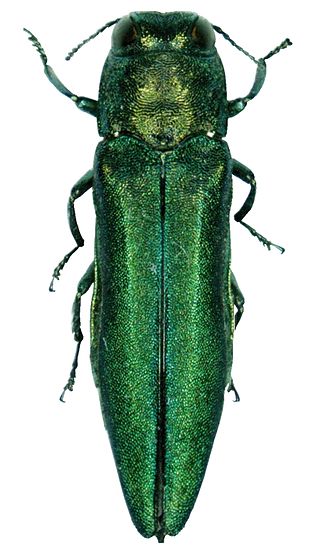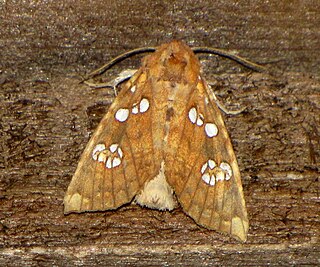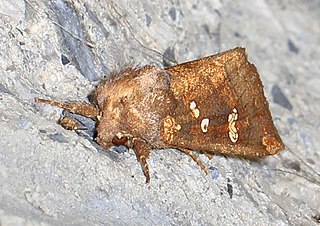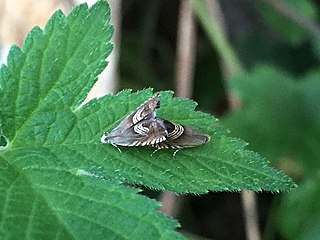
Crambidae comprises the grass moth family of lepidopterans. They are variable in appearance, with the nominal subfamily Crambinae taking up closely folded postures on grass stems where they are inconspicuous, while other subfamilies include brightly coloured and patterned insects that rest in wing-spread attitudes.

The Pyralidae, commonly called pyralid moths, snout moths or grass moths, are a family of Lepidoptera in the ditrysian superfamily Pyraloidea. In many classifications, the grass moths (Crambidae) are included in the Pyralidae as a subfamily, making the combined group one of the largest families in the Lepidoptera. The latest review by Eugene G. Munroe and Maria Alma Solis retain the Crambidae as a full family of Pyraloidea.

The emerald ash borer, also known by the acronym EAB, is a green buprestid or jewel beetle native to north-eastern Asia that feeds on ash species. Females lay eggs in bark crevices on ash trees, and larvae feed underneath the bark of ash trees to emerge as adults in one to two years. In its native range, it is typically found at low densities and does not cause significant damage to trees native to the area. Outside its native range, it is an invasive species and is highly destructive to ash trees native to Europe and North America. Before it was found in North America, very little was known about emerald ash borer in its native range; this has resulted in much of the research on its biology being focused in North America. Local governments in North America are attempting to control it by monitoring its spread, diversifying tree species, and through the use of insecticides and biological control.

Bidens frondosa is a North American species of flowering plant in the aster family, Asteraceae. It is widespread across much of Canada, the United States, and Mexico It is known in many other parts of the world as an introduced species, including Europe, Asia, Morocco, and New Zealand. Its many common names include devil's beggarticks, devil's-pitchfork, devil's bootjack, sticktights, bur marigold, pitchfork weed, tickseed sunflower, leafy beggarticks, and common beggar-ticks.

The Pyraloidea are a moth superfamily containing about 16,000 described species worldwide, and probably at least as many more remain to be described. They are generally fairly small moths, and as such, they have been traditionally associated with the paraphyletic Microlepidoptera.

The European corn borer, also known as the European corn worm or European high-flyer, is a moth of the family Crambidae. It is a pest of grain, particularly maize. The insect is native to Europe, originally infesting varieties of millet, including broom corn. The European corn borer was first reported in North America in 1917 in Massachusetts, but was probably introduced from Europe several years earlier. Since its initial discovery in the Americas, the insect has spread into Canada and westwards across the United States to the Rocky Mountains.

Epiblema otiosana, the bidens borer moth, gets its common name from the genus Bidens which includes the food plants for the larva. An adults wingspan ranges from 12 to 20 mm. They range in North America from Maine and Ontario in the north, south to Florida and west to Kansas and Texas.

Fumibotys is a monotypic moth genus of the family Crambidae which was described by Eugene G. Munroe in 1976. Its single species, Fumibotys fumalis, the mint root borer moth, described by Achille Guenée in 1854, is found in most of North America.

Papaipema is a genus of moths of the family Noctuidae. The genus was erected by John B. Smith in 1899.

Globia oblonga, the oblong sedge borer, is a moth of the family Noctuidae. The species was first described by Augustus Radcliffe Grote in 1882. It is found in parts of Canada and the United States

Globia subflava, the subflava sedge borer or yellow sedge borer, is a moth of the family Noctuidae. The species was first described by Augustus Radcliffe Grote in 1882. It is found in North America from Nova Scotia west to British Columbia, south to New Jersey in the east and Utah and California in the west.

Scolecocampa liburna, the dead-wood borer, is a moth in the family Erebidae. The species was first described by Carl Geyer in 1837. It is found in the US from southern Wisconsin and Michigan to central New England south to Florida and Texas.
Carmenta corni, the aster borer moth, is a moth of the family Sesiidae. It was first described by Henry Edwards in 1881. It is known in North America, including Wisconsin.

Monoptilota is a genus of snout moths. It was described by George Duryea Hulst in 1900. It contains only one species, the lima-bean vine borer moth, which is found in the central and south-eastern parts of the United States.

Papaipema duovata, the seaside goldenrod stem borer or seaside goldenrod borer, is a moth that is native to North America, where it is found in the coastal plain from the gulf coast north to at least New Jersey. The species is listed as threatened in Connecticut. It was described by Henry Bird in 1902.

Papaipema speciosissima, the osmunda borer or regal fern borer, is a species of cutworm or dart moth in the family Noctuidae. It was described by Augustus Radcliffe Grote and Coleman Townsend Robinson in 1868 and is found in North America.

Grapholita delineana, known generally as Eurasian hemp moth, is a species of tortricid moth in the family Tortricidae. Other common names include the hemp moth and hemp borer.
Papaipema aweme, known generally as the Aweme borer moth or small white-aster moth, is a species of cutworm or dart moth in the family Noctuidae. It is found in North America.

Eucopina is a genus of tortricid moths in the family Tortricidae found in North America. There are about nine described species in Eucopina.
















